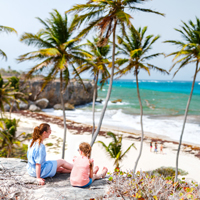Thinking about moving to Praia da Pipa? Below we highlight some of the pros and cons of living in Praia da Pipa.
Imagine waking up to the sound of waves crashing against the shore, the smell of salt in the air, and the sight of a breathtaking sunrise over the Atlantic Ocean. This is a typical morning in Praia da Pipa, a small beach town located in the northeastern state of Rio Grande do Norte, Brazil. Known for its stunning beaches, vibrant nightlife, and diverse wildlife, Pipa is a paradise for many. However, like any place, living here comes with its own set of pros and cons. Let’s delve into what life in Pipa has to offer, and some of the challenges one might face.
Pros of Living in Praia da Pipa
One of the biggest advantages of living in Pipa is undoubtedly its natural beauty. The town is surrounded by pristine beaches such as Praia do Amor and Praia dos Golfinhos, where dolphins can often be spotted frolicking in the waves. The region is also home to the Mata Estrela, a large Atlantic Forest reserve, offering opportunities for hiking and bird watching. The Chapadao, a large cliff with panoramic views of the sea, is another must-visit spot for nature lovers.
Another pro of living in Pipa is the laid-back lifestyle. The pace of life here is slow and relaxed, with a strong emphasis on enjoying the outdoors and socializing with friends and family. This is reflected in the town’s vibrant social scene, which includes a range of bars, restaurants, and live music venues. For instance, the Sunset Bar is a popular spot for locals and tourists alike to enjoy a drink while watching the sun set over the ocean.
Despite its small size, Pipa has a diverse and multicultural community. People from all over the world have made this town their home, contributing to a rich cultural mix. This is evident in the variety of cuisines available in the town’s restaurants, from traditional Brazilian fare to international dishes. The annual Pipa Jazz Festival is another testament to the town’s cultural diversity, attracting musicians and music lovers from around the globe.
For those interested in giving back to the community, there are several volunteer opportunities available in Pipa. The Tamar Project, for example, is a national conservation initiative that works to protect sea turtles along Brazil’s coast. Volunteers can assist with various tasks, including monitoring nesting sites and educating visitors about conservation efforts. Another organization, the Pipa Natureza, focuses on preserving the local environment and promoting sustainable tourism practices.
Cons of Living in Praia da Pipa, Brazil
While Pipa’s natural beauty and relaxed lifestyle are undoubtedly appealing, there are also some challenges to consider when thinking about living here. One of the main cons is the town’s remote location. Pipa is about 80 kilometers from Natal, the nearest major city, and public transportation options are limited. This can make it difficult to access certain services and amenities, such as hospitals and shopping centers.
Another potential downside of living in Pipa is the cost of living. While it’s cheaper than many major Brazilian cities, it’s more expensive than other towns in the region. This is largely due to the town’s popularity as a tourist destination, which has driven up prices for housing, food, and other essentials. For example, a meal at a mid-range restaurant in Pipa can cost around R$50, compared to R$30 in a similar establishment in Natal.
While Pipa’s multicultural community is one of its strengths, it can also present challenges. The town’s popularity with international tourists and expats means that English is widely spoken, which can make it harder for those looking to immerse themselves in Brazilian culture and learn Portuguese. Additionally, the transient nature of the tourist population can make it harder to form lasting connections with locals.
Finally, while Pipa’s natural environment is one of its main attractions, it also presents certain challenges. The town’s coastal location makes it vulnerable to extreme weather events, such as hurricanes and floods. Additionally, the presence of wildlife, while a draw for many, can also pose problems. For instance, monkeys are a common sight in Pipa, and while they are generally harmless, they can be a nuisance, getting into homes and causing damage.


